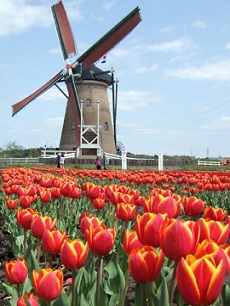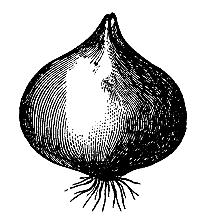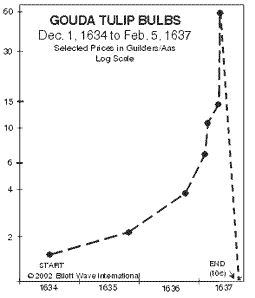By Jesse Colombo (This article was written on May 4th, 2012)
 Could a mere tulip bulb be worth $76,000? It is if people are willing to pay for it. It may sound preposterous, but this is exactly what happened during the Dutch Tulip Mania or Tulipomania of the 1630’s.
Could a mere tulip bulb be worth $76,000? It is if people are willing to pay for it. It may sound preposterous, but this is exactly what happened during the Dutch Tulip Mania or Tulipomania of the 1630’s.
The seeds of the Tulip Mania were planted in 1593, when Conrad Guestner imported the first tulip bulb into Holland from Constantinople, in present day Turkey. After a few years, tulip bulbs became a status symbol and a novelty for Holland’s upper classes. Eventually, tulip bulbs became a hot-ticket item in neighboring Germany as well.
After some time, a few tulip bulbs contracted the non-harmful mosaic virus, which caused tulips to grow petals with beautiful “flames” of color. This unique effect increased the value of the already rare and highly exclusive tulip bulb.
Initially, only true connoisseurs bought tulip bulbs, but the rapidly rising price quickly attracted speculators looking to profit. It didn’t take long before tulip bulbs were traded on local market exchanges, which were similar to modern stock exchanges. By 1634, tulip mania had spread to the Dutch middle classes and soon practically everybody was trading tulip bulbs, looking to make a quick fortune. The majority of tulip bulb buyers had no intention of planting these bulbs – the name of the game was to buy low and sell high, just like in any other financial market. The entire nation was caught in a sweeping mania and some people even traded in their land, livestock, farms and life savings to acquire a single tulip bulb.
At the peak of the mania, the price of tulip bulbs went up twenty-fold in just one month.To put that into perspective, a person who had invested $1,000 in tulip bulbs would have seen their investment balloon to $20,000. With gains such as these, it is not hard to understand the mad rush to buy tulip bulbs at any cost. Tulip bulb mania affected the public psyche to an extreme. One drunk man in a bar started peeling and eating what he thought was an onion, while it was actually the bar owner’s tulip bulb on display. The infuriated bar owner had this man jailed for many months.
All common sense and logic was thrown to the wind and practically scoffed at – this is exemplified by how many useful items it cost to buy one single tulip bulb:
• four tons of wheat
• eight tons of rye
• one bed
• four oxen
• eight pigs
• 12 sheep
• one suit of clothes
• two casks of wine
• four tons of beer
• two tons of butter
• 1,000 pounds of cheese
• one silver drinking cup.
The modern day value of these items is over $40,000.
By 1636, tulips were trading on the Amsterdam Stock Exchange as well as on exchanges in Rotterdam, Harlem, Levytown, Horne and many others in other nearby European countries. These exchanges started to offer option contracts, which allowed speculators to trade in the tulip bulb market for a fraction of the price of a real tulip bulb. The low cost of trading tulip bulb contracts was a boon for non-wealthy Dutch who wanted to speculate in the tulip market. Options also gave traders the ability to use leverage in their trading of tulip bulbs, which could dramatically increase their potential profits. In a previous example, we showed how a $1,000 investment in tulip bulbs could have yielded a $20,000 profit in one month. Despite how impressive that sounds, a buyer of tulip bulb options would have seen their investment of $1,000 balloon to an incredible $100,000. Unfortunately, leverage is a double-edged sword – if tulip bulb prices moved lower by even a small amount, the option buyer’s investment could have been completely lost. An even larger adverse move in tulip prices could have caused traders to lose more than their initial investment. Despite these obvious risks, Dutch traders aggresively speculated in tulip bulb options due to the common belief that the tulip market was immune to falling and that it would “always go up”.
Dutch who wanted to speculate in the tulip market. Options also gave traders the ability to use leverage in their trading of tulip bulbs, which could dramatically increase their potential profits. In a previous example, we showed how a $1,000 investment in tulip bulbs could have yielded a $20,000 profit in one month. Despite how impressive that sounds, a buyer of tulip bulb options would have seen their investment of $1,000 balloon to an incredible $100,000. Unfortunately, leverage is a double-edged sword – if tulip bulb prices moved lower by even a small amount, the option buyer’s investment could have been completely lost. An even larger adverse move in tulip prices could have caused traders to lose more than their initial investment. Despite these obvious risks, Dutch traders aggresively speculated in tulip bulb options due to the common belief that the tulip market was immune to falling and that it would “always go up”.
After some time, the Dutch government started to develop regulations to help control the tulip mania. It was at this point that a few informed speculators started to liquidate their tulips bulbs and contracts to lock-in their profits. In addition, more tulip bulbs were added to the supply due to increasingly large tulip bulb harvests.  Suddenly, tulip bulbs weren’t quite as rare as they were before. Tulip prices began to ease, gently at first, and then started to plummet at a much faster rate than prices rose. Suddenly, the market experienced a widespread panic as traders rapidly began to realize that tulips were not worth the prices people were paying for them. In less than six weeks, tulip prices crashed by over 90%, causing vast fortunes to be lost.
Suddenly, tulip bulbs weren’t quite as rare as they were before. Tulip prices began to ease, gently at first, and then started to plummet at a much faster rate than prices rose. Suddenly, the market experienced a widespread panic as traders rapidly began to realize that tulips were not worth the prices people were paying for them. In less than six weeks, tulip prices crashed by over 90%, causing vast fortunes to be lost.
As tulip bulb prices crashed, wealthy tulip traders became paupers virtually overnight. Many tulip bulb option traders became bankrupt after they lost far more than their initial investments. People who traded their farms and live savings for tulip bulbs were left holding a practically worthless plant seed.
The Dutch government avoided intervening in the tulip bulb crash and only advised tulip speculators to form a council to attempt to stabilize prices and bolster public confidence. Every one of these plans failed miserably as tulip prices plummeted even lower than before.
Eventually, Amsterdam’s assembled deputies nullified all of the contracts purchased at the height of the tulip mania and city’s supreme judges declared all tulip speculation to be a form of gambling and refused to honor these contracts. As a result, payments on tulip bulb contracts were no longer enforced by any of Holland’s courts, which caused the tulip bulb market to crash even harder.
The tulip bulb crash threw the Dutch economy into a mild economic depression that lasted for many years.
Other Dutch Tulip Mania Resources:
The Dutch “Tulip Mania” Bubble (aka “Tulipomania”)
Market Crashes: The Tulip and Bulb Craze
Questions? Comments?
Click on the buttons below to discuss or ask me any question about this topic on Twitter or Facebook and I will personally respond:


